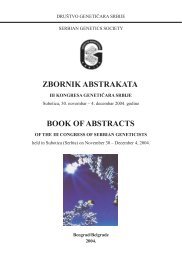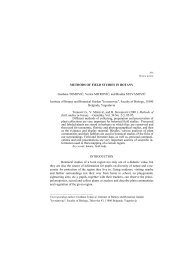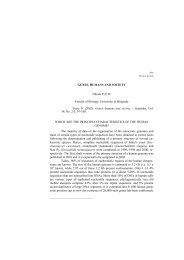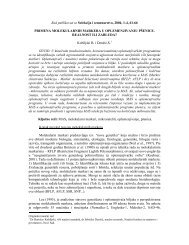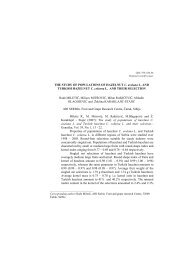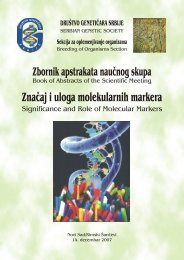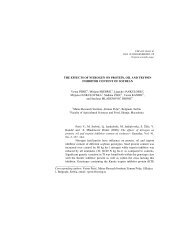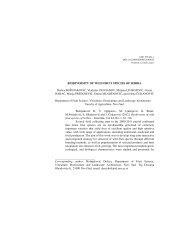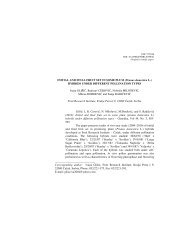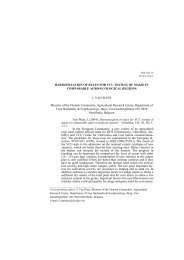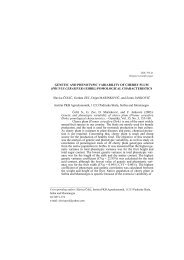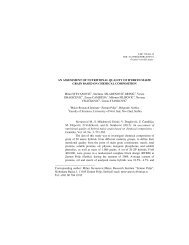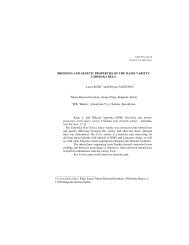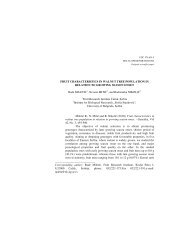Characteristics important for organic breeding of vegetable crops
Characteristics important for organic breeding of vegetable crops
Characteristics important for organic breeding of vegetable crops
You also want an ePaper? Increase the reach of your titles
YUMPU automatically turns print PDFs into web optimized ePapers that Google loves.
UDC 575.635.1/.8<br />
DOI: 10.2298/GENSR1002223Z<br />
Original scientific paper<br />
CHARACTERISTICS IMPORTANT FOR ORGANIC BREEDING OF<br />
VEGETABLE CROPS<br />
Jasmina ZDRAVKOVIC 1 , Nenad PAVLOVIC 1 , Zdenka GIREK 1 ,<br />
Milan ZDRAVKOVIC 1 and Dejan CVIKIC 1<br />
1 Institute <strong>for</strong> Vegetable Crops, Smederevska Palanka, Serbia<br />
Zdravković J., N. Pavlović, Z. Girek, M.Zdravković and D. Cvikić<br />
(2010): <strong>Characteristics</strong> <strong>important</strong> <strong>for</strong> <strong>organic</strong> <strong>breeding</strong> <strong>of</strong> <strong>vegetable</strong> <strong>crops</strong>-<br />
Genetika, Vol 42, No. 2, 223 -233.<br />
The remarkable development and application <strong>of</strong> new genetic The<br />
Institute <strong>for</strong> Vegetable Crops possesses a rich germplasm collection <strong>of</strong><br />
<strong>vegetable</strong>s, utilized as gene resource <strong>for</strong> <strong>breeding</strong> specific traits. Onion and<br />
garlic <strong>breeding</strong> programs are based on chemical composition improvement.<br />
There are programs <strong>for</strong> identification and use <strong>of</strong> genotypes characterized by<br />
high tolerance to economically <strong>important</strong> diseases. Special attention is paid<br />
to <strong>breeding</strong> cucumber and tomato lines tolerant to late blight. As a result,<br />
____________________________<br />
Corresponding author: Jasmina Zdravkovic, Institute <strong>for</strong> Vegetable Crops,<br />
Karađorđeva 71, 11420 Smederevska Palanka, Serbia, Phone: 381 26 323 170, fax<br />
381 26 323 785, e-mail: jzdravkovic@institut-palanka.co.rs
224 GENETIKA, Vol. 42, No. 2,223 -233, 2010<br />
late blight tolerant pickling cucumber line, as well as late blight tolerant<br />
tomato lines and hybrids are realized. Research on bean drought stress<br />
tolerance is initiated. Lettuce <strong>breeding</strong> program including research on<br />
spontaneous flora is started and interspecies hybrids were observed as<br />
possible genetic variability source. It is <strong>important</strong> to have access to a broad<br />
range <strong>of</strong> <strong>vegetable</strong> genotypes in order to meet the needs <strong>of</strong> <strong>organic</strong><br />
agriculture production. Appreciating the concept <strong>of</strong> sustainable agriculture,<br />
it is <strong>important</strong> to introduce <strong>organic</strong> agriculture programs in <strong>breeding</strong><br />
institutions.<br />
Key words: disease tolerance, <strong>organic</strong> <strong>breeding</strong>, specific traits,<br />
<strong>vegetable</strong> germplasm<br />
INTRODUCTION<br />
The concept <strong>of</strong> sustainable agriculture implies the application <strong>of</strong> the acquired<br />
knowledge in order to produce healthy food (LAZIC, 2008). The regulation <strong>of</strong> the<br />
World Health Organization, Codex Alimentarius, complies controlling the critical<br />
points <strong>of</strong> the production and the quality in the context <strong>of</strong> regulation, as well as using<br />
the natural resources. The ultimate aim to be achieved is the viable systems <strong>of</strong><br />
production that are socially justified, economically payable and productive, and at<br />
the same time to protect health, improve community and animal welfare, and provide<br />
the safe environment.<br />
Vegetable production based on sustainable agriculture is <strong>of</strong> interest to:<br />
1. Small-scale, medium and large producers, through the value added and<br />
better conditions <strong>of</strong> sale at the market<br />
2. Consumers, by better quality and healthy food that is produced in<br />
sustainable manners<br />
3. Economy and industry, by greater pr<strong>of</strong>it from better products<br />
4. Everybody, by higher quality <strong>of</strong> the environment<br />
Tendencies <strong>of</strong> future plant selection will be on high production, better quality,<br />
optimization <strong>of</strong> production with low input <strong>of</strong> fertilizers and pesticides, tolerance to<br />
stresses and diseases (VAN WEAS, 2003).<br />
Following the principles <strong>of</strong> the sustainable manners <strong>of</strong> agricultural<br />
production, the manners <strong>of</strong> work <strong>for</strong> each production system is defined, regarding the<br />
specific qualities <strong>of</strong> the agrosystem, including the conditions: soil, water, agricultural<br />
production, <strong>crops</strong> protection, <strong>breeding</strong> cattle, health <strong>of</strong> the cattle, cattle welfare,<br />
harvesting, processing and storing, welfare, health and safety <strong>of</strong> the population,<br />
animals and the landscape.<br />
There<strong>for</strong>e, the sphere <strong>of</strong> interest <strong>for</strong> the <strong>vegetable</strong> selection researchers is in<br />
the field <strong>of</strong> their contribution to the agricultural production within the scope <strong>of</strong><br />
selecting the varieties, regarding the needs <strong>of</strong> the market, and in accordance with the<br />
environmental conditions, available resources; all these in order to preserve the<br />
fertility <strong>of</strong> the soil, prevent the development <strong>of</strong> the weeds, pests and diseases.<br />
Crops grown in <strong>organic</strong> system must have familiar seed origin, so called certified<br />
seed (BOLETIN OFICIAL 1999). Markets <strong>for</strong> this kind <strong>of</strong> <strong>vegetable</strong>s are in expansion.
J. ZDRAVKOVIC et al.: ORGANICS BREEDING OF VEGETABLE CROPS 225<br />
However, there are no necessary quantities <strong>of</strong> seed <strong>for</strong> <strong>organic</strong> production<br />
(THOMPSON, 2000).<br />
Agricultural Institutes in Serbia pay special attention to <strong>breeding</strong> <strong>of</strong> plant<br />
species and monitor the progress in this area. However, the finalization <strong>of</strong> these<br />
projects requires greater Government support. We are facing the lack <strong>of</strong> certified<br />
seed <strong>for</strong> <strong>organic</strong> production on the market today. Producers showed special interest<br />
<strong>for</strong> certain <strong>vegetable</strong> species such as peas, beans, green beans, onions, garlic,<br />
cucumbers, tomatoes and lettuce. Also, <strong>organic</strong> seed is crucial <strong>for</strong> scientific<br />
researches in selection, seed production and <strong>organic</strong> production <strong>of</strong> <strong>vegetable</strong>s.<br />
Organic seed provides all necessary inputs <strong>for</strong> entire <strong>organic</strong> production (VALEMA,<br />
2004).<br />
The aim <strong>of</strong> this research was the characterization <strong>of</strong> <strong>organic</strong> <strong>vegetable</strong><br />
<strong>breeding</strong> <strong>of</strong> certain species and seed production through quality, yield and resistance<br />
to plant pathogens in the agro-ecological conditions in Serbia.<br />
SELECTION TECHNOLOGIES FOR CREATING VEGETABLE VARIETIES<br />
FOR SPECIFIC PURPOSES<br />
Plant <strong>breeding</strong> is based on genetic variability, selection and recombination. It is<br />
multidisciplinary and creative work which is based on scientific disciplines such as<br />
genetics, physiology, molecular biology, growing technology and plant protection<br />
(VAN WEAS, 2003).<br />
Compared to the methods available <strong>for</strong> conventional plant <strong>breeding</strong>, there are some<br />
limitations on the choice <strong>of</strong> the method <strong>for</strong> <strong>organic</strong> <strong>breeding</strong>. These methods can be<br />
classified as: permitted methods - intraspecific crossing, backcrossing, mass<br />
selection, individual selection, <strong>for</strong>bidden methods – interspecific crossing, protoplast<br />
fusion, genetic modification, induced mutations and conditionally permitted – use <strong>of</strong><br />
hybrid varieties, somatic embryogenesis, meristem culture, and in vitro<br />
micropropagation anther culture.<br />
1. The application <strong>of</strong> genetically modified organisms or their derivatives is<br />
banned in the <strong>organic</strong> production. Such a ban is included in our Organic<br />
Production and Organic Products Act ("Official Gazette <strong>of</strong> the RS", 62/06):<br />
"Genetically modified organisms and their derivatives cannot be used in<br />
<strong>organic</strong> production." (BERENJI, 2005).<br />
2. Of the modern biotechnology methods, only the method <strong>of</strong> indirect<br />
selection via molecular markers is permitted because this method does not<br />
affect the change <strong>of</strong> the genetic plant construction.<br />
3. The compromise <strong>for</strong> hybrid varieties that can be used in <strong>organic</strong> production<br />
is accepted, if they are fertile and if the sterility in the process <strong>of</strong> hybrid<br />
seed production is not chemically caused. Most probably, in <strong>organic</strong><br />
production will be developed the three-line (TC) and four-line (DC), and<br />
not the two-line hybrids that dominate in the conventional production.
226 GENETIKA, Vol. 42, No. 2,223 -233, 2010<br />
4. The application <strong>of</strong> the cytoplasmic male sterile products is banned, except if<br />
the fertility is permanently restored and it continues in further generations<br />
<strong>of</strong> propagation.<br />
5. Neither direct nor indirect application <strong>of</strong> the genetic material that contains<br />
induced mutations is permitted.<br />
6. The application <strong>of</strong> silver nitrate, silver thiosulfate, synthetic hormones,<br />
antibiotics and colchicines is banned in <strong>organic</strong> plant <strong>breeding</strong> (BERENJI,<br />
2008).<br />
RESULTS ACHIEVED IN THE DEVELOPMENT OF VEGETABLE VARIETIES<br />
FOR SPECIFIC PURPOSES<br />
Cucumber selection<br />
Cucumbers belong to leading species in the <strong>vegetable</strong> production in<br />
Yugoslavia. Continuous dissemination <strong>of</strong> its <strong>breeding</strong> range has been possible due to<br />
multiple usage and wide agro-ecological adaptability. Besides the fact that fruits are<br />
used in nutrition, both fresh and processed, it is also a raw material <strong>of</strong> the<br />
pharmaceutical industry.<br />
However, <strong>breeding</strong> <strong>of</strong> this crop has been intensified only in recent 30 years<br />
in Serbia. Tendency <strong>of</strong> spreading production and increasing the use <strong>of</strong> cucumber in<br />
Serbian nutrition requires a wide range <strong>of</strong> varieties <strong>for</strong> pickling and <strong>for</strong> salad.<br />
There<strong>for</strong>e, it is necessary to increase the number <strong>of</strong> cultivars <strong>for</strong> market and <strong>for</strong><br />
consumers. Current trend <strong>of</strong> cucumber <strong>breeding</strong> in Serbia is heading towards the<br />
selection <strong>of</strong> genotypes with better quantitative characteristics. In the first place, these<br />
are varieties with non-bitter fruits, straight shape and with high yield. The exploiting<br />
<strong>of</strong> parthenocarpy <strong>of</strong> salad type <strong>of</strong> cucumber is also a current trend. New parthenocarp<br />
cucumber genotypes were intended <strong>for</strong> production in greenhouses.<br />
Cucumber <strong>breeding</strong> to resistance to diseases is <strong>of</strong> great importance<br />
(PAVLOVIC et al., 2002). Downy (Pseudoperonospora cubensis (Berk and Curt.)<br />
Rostow) and Cucumber Mosaic Virus cause the greatest problems in cucumber<br />
growing in Serbia as well as in other parts <strong>of</strong> the world (METWALLY and WEHNER,<br />
1990).<br />
Finding and identifying the selection material <strong>for</strong> these, economically most<br />
<strong>important</strong> diseases is <strong>of</strong> the greatest priority. The use <strong>of</strong> chemicals in cucumber<br />
protection <strong>of</strong> downy has reached emergency proportions. This too can be overcome<br />
only by <strong>breeding</strong> resistant genotypes in <strong>organic</strong> systems <strong>of</strong> production. Today, the<br />
Institute <strong>for</strong> Vegetable Crops has cucumber lines that are highly tolerant to downy<br />
mildew in conditions <strong>of</strong> spontaneous infection.<br />
The Institute <strong>for</strong> Vegetable Crops in Smederevska Palanka possesses a<br />
collection <strong>of</strong> cucumber germplasm consisted <strong>of</strong> over 100 divergent genotypes that<br />
are included in our <strong>breeding</strong> programs. Pickling cucumber hybrid characterized with<br />
high tolerance to this plant pathogen was created using experimental crossings.<br />
Based on the results from the trial at the Institute <strong>for</strong> Vegetable Crops, the pickling
J. ZDRAVKOVIC et al.: ORGANICS BREEDING OF VEGETABLE CROPS 227<br />
cucumber named Sirano F1 is marked as the pickling cucumber hybrid that is the<br />
most resistant to blight (PAVLOVIC et al., 2006).<br />
Bulb <strong>vegetable</strong>s selection<br />
Garlic draws more and more attention as an industrial plant and its<br />
production is perspective. Garlic is characterized by high contents <strong>of</strong> dry matter,<br />
proteins, fats, carbohydrates, vitamin C, thiamine, and B6. Furthermore, garlic is rich<br />
with minerals such as: Mg, Zn, Mn, Cu, Mo, and Se. It also possesses high energy<br />
values that can be paired with members <strong>of</strong> Fabaceae family. Through the new<br />
<strong>breeding</strong> programs, the chemical structure <strong>of</strong> garlic is emphasized. Based on detailed<br />
chemical analysis the best ecotypes are selected. The aim <strong>of</strong> the research was to<br />
create the ecotypes with the most favourable chemical composition, which would<br />
give valuable contribution to the process <strong>of</strong> utilization <strong>of</strong> this <strong>vegetable</strong> variety<br />
(PAVLOVIC et al., 2003a).<br />
High biological value <strong>of</strong> onion is the result <strong>of</strong> its specific chemical<br />
composition dominated by sugars, vitamin C and characteristic ethereal oil.<br />
According to the average contents <strong>of</strong> vitamin C in bulbs (32.46 to 44.03 mg %),<br />
onion is a significant natural source <strong>of</strong> this vitamin. In our research higher genotypic<br />
variance and the phenotype variation coefficient is found, as compared to the<br />
ecological variance and the genotype variation coefficient. This suggests an<br />
<strong>important</strong> role <strong>of</strong> the genetic factors in the expression <strong>of</strong> this trait (PAVLOVIC et al.,<br />
2003b). It is confirmed with the broad-sense heritability values (0.75 and 0.76%).<br />
For dehydration in food industry only the onion genotypes with high percentage <strong>of</strong><br />
dry matter contents are used. In many countries today, there are selection programs<br />
<strong>for</strong> the development <strong>of</strong> genotypes only <strong>for</strong> drying purposes. Variability <strong>of</strong> the<br />
chemical composition <strong>of</strong> onion in the field caused by climatic and soil conditions, as<br />
well as by the agricultural techniques is characteristic. Dry matter percentage in<br />
particular varieties suggests the part <strong>of</strong> the total bulb mass that can be used in the<br />
food production industry. In our research a high genotypic variability <strong>of</strong> the dry<br />
matter contents is found (PAVLOVIC et al., 2007).<br />
Tomato selection<br />
Tomato represents one <strong>of</strong> the most <strong>important</strong> sources <strong>of</strong> lycopene. It also<br />
contents a high level <strong>of</strong> other carotenoids (β-carotene), vitamins (vitamin C),<br />
minerals, flavonoids and phenolic acid. Antioxidant effects <strong>of</strong> the substances affect<br />
on the reduction <strong>of</strong> the possibility <strong>for</strong> human to contract diseases; the substances<br />
affect on the proliferation <strong>of</strong> cancerous cells; and act as preventive <strong>for</strong> cardiovascular<br />
diseases. Nutritional estimation <strong>of</strong> the optimal antioxidant quantity through daily<br />
consummation <strong>of</strong> tomato is 9-18 mg <strong>of</strong> carotenoids, 175-400 mg <strong>of</strong> vitamin C, 3-4<br />
mg <strong>of</strong> vitamin E, 50 mg <strong>of</strong> flavonoids, 0.4 mg <strong>of</strong> folate and 25-30 mg <strong>of</strong> lycopene.<br />
Tomato is consider as a rich source (in 100 g) <strong>of</strong>: vitamin C (20-29 mg), carotene<br />
(0.2-2.3 mg) and phenolic acid (1-2000 mg), regarding to the total antioxidant<br />
contents. There are also small portions <strong>of</strong> vitamin E (0.49 mg), flavonoids (0.5-5 mg)<br />
and traces <strong>of</strong> selenium (0.5-10 mg), copper (90 mg) and zinc (240 µg). It is
228 GENETIKA, Vol. 42, No. 2,223 -233, 2010<br />
recommended to consume 400 g per day <strong>of</strong> fresh tomato or other tomato products in<br />
five portions. Lycopene is one <strong>of</strong> the carotenoids that give naturally color to the<br />
tomato fruit and rank among the strongest antioxidants among all the other<br />
carotenoids. The intensive selection <strong>for</strong> tomato lycopene content has been<br />
per<strong>for</strong>med. With adequate selection <strong>of</strong> the lines that will be used in hybrid<br />
development, it is expected that in process <strong>of</strong> the gene recombination we will get the<br />
most favorable nutritive contents ratio – especially antioxidants, with a particular<br />
emphasis on a lycopene (ZDRAVKOVIC et al., 2002a, 2003c, 2007).<br />
Late blight, which is caused by the fungus Phytophtora infestans, emerges<br />
in tomato <strong>crops</strong> almost every year and causes considerable economic damages.<br />
Fungicide control <strong>of</strong> this parasite is not always effective and satisfactorily. The<br />
solution to this problem is in growing less sensitive or more resistant tomato<br />
varieties or hybrids. The research on tomato resistance to Phytophtora infestans is<br />
very complex due to high variability <strong>of</strong> the pathogen physiological races. Tomato<br />
genotypes that are the carriers <strong>of</strong> Ph-2 gene <strong>of</strong> resistance to this parasite were crossed<br />
with tomato genotypes with good production characteristics (yield and fruit quality)<br />
but more susceptible to this parasite. Successfully were selected tomato lines and<br />
hybrids that expressed a higher level <strong>of</strong> resistance than their parents (MIJATOVIC et<br />
al., 2007; ZDRAVKOVIC et al., 2004).<br />
Special projects were launched aimed to the effect <strong>of</strong> partial drying part <strong>of</strong> a<br />
root (PRD-treatment) on the growth <strong>of</strong> tomato plant, photosynthesis, transpiration,<br />
water potential, peroxidase activation <strong>of</strong> the cell wall, yield, sugar contents, lycopene<br />
contents, mineral contents and dry matter content. This treatment causes the increase<br />
<strong>of</strong> peroxidase activity and sugar contents in mature tomato fruits (STIKIC et al.,<br />
2003).<br />
Tomato fruit firmness can be achieved by entering a gene <strong>for</strong> delayed<br />
maturation (rin, nor, alc) in the selection <strong>of</strong> tomatoes. There<strong>for</strong>e, the process stops<br />
the ripening on a certain level <strong>of</strong> maturity. As a result <strong>of</strong> interrupted maturation<br />
process, satisfactory fruit firmness occurs, but with slightly less sugar, lycopene, beta<br />
carotene, etc. (CVIKIĆ et al., 2000, ZDRAVKOVIC et al. 2008). Breeding <strong>for</strong> this trait<br />
in this manner are in opposite to the selection requirements <strong>for</strong> <strong>organic</strong><br />
production. Fruits with greater firmness can be selected by accumulating firmness<br />
traits (ZDRAVKOVIC et al., 2007, 2008). Genotypes with "fruit firmness" gene cause<br />
long shelf life <strong>of</strong> mature tomato. (ZDRAVKOVIC et al., 2003, MARKOVIC et al., 2008).<br />
Investigation <strong>of</strong> inheritance <strong>of</strong> yield and yield components in all plant<br />
species and in tomato is very <strong>important</strong>. Gene expression effects nutritional and<br />
quality characteristics and there<strong>for</strong>e the selection may lead to its increase and<br />
decrease (ZDRAVKOVIC et al., 2000, ATANASOVA and GEORGIEV, 2009).<br />
The purpose <strong>of</strong> <strong>breeding</strong> <strong>crops</strong> with specific features designed <strong>for</strong> <strong>organic</strong><br />
or other sustainable production requires researches in the field <strong>of</strong> seed production, so<br />
the results could be available to producers through new varieties. (VAN WEAS, 2003).<br />
Important features <strong>of</strong> research must be prices <strong>of</strong> seeds and final products. These<br />
aspects require a comparative analysis <strong>of</strong> conventional production and integrated<br />
crop management and <strong>organic</strong> methods (BRUMFIELD et al. 2000).
J. ZDRAVKOVIC et al.: ORGANICS BREEDING OF VEGETABLE CROPS 229<br />
Dry beans selection<br />
The project <strong>of</strong> <strong>breeding</strong> dry beans resistant to stressful conditions <strong>of</strong> drought<br />
has been set out at the Institute <strong>for</strong> Vegetable Crops, and aim <strong>of</strong> the project was<br />
controlling the negative effects <strong>of</strong> a high temperature and low rainfall. In our<br />
research 62 genotypes were used. Pure lines suitable <strong>for</strong> further selection have been<br />
chosen. The number <strong>of</strong> nodes in the pure lines is not dependent on the water quantity<br />
<strong>for</strong> irrigation, which includes them in the next <strong>breeding</strong> phase <strong>for</strong> stressful conditions<br />
(ZDRAVKOVIC M. et al., 2004a; ZDRAVKOVIC M. et al., 2004b). The effects <strong>of</strong> two<br />
microbiological fertilizers (SOJ 1 and SOJ 2) have been investigated on dry beans, in<br />
the variation with and without additional nutrition with mineral fertilizers (KAN).<br />
The first pod height was recorded. Microbiological fertilizers do not affect on this<br />
trait, whereas they exhibited a significant effect on the bean mass per plant (JARAK et<br />
al., 2007).<br />
Lettuce selection<br />
Aimed at creating lettuce cultivars (Lactuca sativa L.) resistant to<br />
pathogens, the causal agents <strong>of</strong> plant diseases, and especially to virus diseases,<br />
research was carried out on the spontaneous flora in the locality <strong>of</strong> Pomoravlje and<br />
Sumadija where the genotypes <strong>of</strong> the species Lactuca sp. that are resistant to causal<br />
agents <strong>of</strong> virus diseases could be found. The interspecies hybrids Lactuca virosa L. x<br />
Lactuca sativa L., L. saligna L. x L. sativa L., were investigated as possible sources<br />
<strong>of</strong> genetic variability. L. saligna L. and L. virosa L. represent only a part <strong>of</strong> the<br />
population related to L. sativa L. Wild varieties <strong>of</strong> this species belong to the weed<br />
flora. After crossing, viable achenes were obtained only in the crossing L. sativa L. x<br />
L. saligna L. At initial crossings two populations <strong>of</strong> L. saligna L. were used, one<br />
with and the other without anthocyanin. The seedlings <strong>of</strong> L. saligna L. without<br />
anthocyanin were lost after brought out on the field. In the process <strong>of</strong> the selection <strong>of</strong><br />
F1 generation, 31 plants emerged. After transplantation on the field, only 19 plants<br />
survived. In 9 plants the fertility was provoked by colchicine, but the percentage <strong>of</strong><br />
fertile achenes was low as compared to the number <strong>of</strong> achenes that were not viable.<br />
By collecting more genotypes <strong>of</strong> the species Lactuca sp. from spontaneous flora in<br />
the locality <strong>of</strong> Pomoravlje and Sumadija and investigating the possibilities <strong>of</strong><br />
crossing with the cultivated lettuce (Lactuca sativa L.), the selection programs <strong>of</strong> this<br />
kind would be improved. Eventually, the final aim is to obtain the cultivar with the<br />
built-in genes <strong>of</strong> resistance to virus diseases and acceptable morphological<br />
characteristics (ZDRAVKOVIC et al., 2003b).<br />
Our investigation was based on the problem <strong>of</strong> anthocyanin and vitamin C<br />
contents inheritance in F1 progeny <strong>of</strong> lettuce. It was assumed that progenies with<br />
increased contents <strong>of</strong> these substances could be obtained. Diallel crossing <strong>of</strong> eight<br />
lettuce genotypes <strong>of</strong> different anthocyanin and vitamin C contents, classified into<br />
three varieties was per<strong>for</strong>med. Parental and F1 generations were investigated<br />
comparatively, and their mode <strong>of</strong> inheritance was determined. Concerning the<br />
inheritance <strong>of</strong> anthocyanin, dominant genes prevailed, and a higher content <strong>of</strong> this<br />
substance was succeeded in F1 generation. Concerning the inheritance <strong>of</strong> vitamin C
230 GENETIKA, Vol. 42, No. 2,223 -233, 2010<br />
content, dominance mode <strong>of</strong> inheritance was recorded, when it was compared to the<br />
parents with the lower vitamin C content. Apart from the dominance mode <strong>of</strong><br />
inheritance, significant additive gene effects in inheriting vitamin C content was also<br />
recorded (ZDRAVKOVIC et al. 2002a; ZDRAVKOVIC et al. 2002b).<br />
CONCLUSION<br />
Irreplaceability <strong>of</strong> plants in human diet as well as negative urban and<br />
industrial development impact on ecosystems imposes the need <strong>for</strong> planning the<br />
<strong>breeding</strong> programs <strong>for</strong> specific purposes.<br />
With the respect to the concept <strong>of</strong> viable agriculture and giving preference<br />
to biodiversity, intensifying and supporting such <strong>breeding</strong> programs at the Institutes<br />
becomes a necessity. The tendency <strong>of</strong> developing a new concept <strong>of</strong> agricultural<br />
production and greater consumption <strong>of</strong> healthy plants and their derivatives in human<br />
diet requires the existence <strong>of</strong> a broad range <strong>of</strong> <strong>vegetable</strong> varieties. It is <strong>of</strong><br />
considerable importance to change the method <strong>of</strong> organizing the agricultural<br />
production, as well as passing new laws that would support and facilitate the<br />
introduction <strong>of</strong> the concept <strong>of</strong> viable development <strong>of</strong> the agro-system. The Institute<br />
<strong>for</strong> Vegetable Crops in Smederevska Palanka possesses a large collection <strong>of</strong><br />
germplasm <strong>of</strong> <strong>vegetable</strong> varieties, which enables selecting the donors with<br />
favourable genes <strong>for</strong> some specific traits. This represents the basis <strong>for</strong> planning and<br />
modeling the ideotypes <strong>of</strong> <strong>vegetable</strong> varieties.<br />
REFERENCES<br />
Received August28 th , 2009<br />
Accepted April 18 th , 2010<br />
ATANASSOVA, B., H. GEORGIEV (2009): Part 4: Expression <strong>of</strong> heterosis by hybridization. Genetic<br />
improvement <strong>of</strong> Solanaceus Crops. Volume 2: Tomato. Science Publishers, Jersey, Plymouth.<br />
113-151.<br />
BERENJI, J. (2004): Organic plant <strong>breeding</strong>. Book <strong>of</strong> abstracts. III Congress <strong>of</strong> Serbian Genetics, Subotica,<br />
Serbia and Montenegro, 87.<br />
BERENJI, J. (2005): Ethic aspects <strong>of</strong> GMO - transgenic plants. Journal <strong>of</strong> Scientific Agricurtural Research,<br />
66 (5), 187-193.<br />
BERENJI, J. (2008): Organic plant <strong>breeding</strong> and <strong>organic</strong> seed production. Book <strong>of</strong> abstracts <strong>of</strong> V Scientific -<br />
research symposium on <strong>breeding</strong> and seed production, Vrnjačka Banja, Serbia, May 25-28 th ,<br />
4.<br />
BOLETIN OFICIAL DE LA REPUBLICA ARGENTINA (1999): Ley 25127/1999 Production ecological, biological<br />
and <strong>organic</strong>. BO no. 2928,13/9/1999.<br />
BRUMFIELD, G.R., A.RIMAL, S RIENERS (2000): Comparative Cost Analyses <strong>of</strong> Conventional Integrated<br />
Crop Management and Organic Methods. Horticultural Technology 10 (4): 785-793.
J. ZDRAVKOVIC et al.: ORGANICS BREEDING OF VEGETABLE CROPS 231<br />
CVIKIC, D. J..ZDRAVKOVIC, I .LJUBANOVIC-RALEVIC., G. SURLAN-MOMIROVIC, Z.SUSIC (2000): β-Carotene<br />
content and its changing dynamics in the investigated nor and rin tomato genotypes. Acta<br />
horticulture, 579: 145-149<br />
JARAK, M., M. ZDRAVKOVIC, S. ĐURIC.and J.ZDRAVKOVIC (2007): Bi<strong>of</strong>ertilization in bean production.<br />
Proceedings I International Congress Food technology, quality and safety, Novi Sad, Serbia,<br />
13-15. November, 135-141.<br />
LAZIC, B. (2008): Good agricultural practice – a part <strong>of</strong> sustainable agriculture. Magazine Agriculture, II<br />
Symposium "Healthy – Organic" Selenca, September 26 – 27 th , 2 – 3.<br />
MARKOVIC Z., J. ZDRAVKOVIC, M.DAMJANOVIC, M. ZDRAVKOVIC and R. DJORDJEVIC (2008): New tomato<br />
hybrids with Long Shelf life. Acta horticulture 789, p.137-140.<br />
METWALLY M. I., T. C. WEHNER (1990): Breeding cucumbers <strong>for</strong> fresh-market production in Egypt. CGC<br />
Rpt. No. 13, 12 – 14.<br />
MIJATOVIC, M., J.ZDRAVKOVIC and Ž. MARKOVIC (2007): Reaction <strong>of</strong> some tomato cultivars and hybrids to<br />
late blight (P. infestans Mont. De Bary). Acta Horticulture, 729, 463-466.<br />
PAVLOVIC, N., LJ.STANKOVIC, M. MIJATOVIC (2002a). The history <strong>of</strong> cucumber <strong>breeding</strong> in Yugoslavia.<br />
Book <strong>of</strong> proceedings. Cucurbitaceae, 8-12 December, Naples, USD 78-81.<br />
PAVLOVIC, N., J.ZDRAVKOVIC and T.SRETENOVIC-RAJIČIC (2002b): Variability and heritability <strong>of</strong> the onion<br />
bulb fresh weight. Yearbook <strong>of</strong> the Faculty <strong>of</strong> Agriculture, University „Ss. Cyril and<br />
Methodius”, Skopje, Macedonia, 47, 171-175.<br />
PAVLOVIC, N., J.ZDRAVKOVIC and D.CVIKIC (2003b): Content and variability <strong>of</strong> vitamin c in onion bulbs<br />
(Allium cepa L.). Book <strong>of</strong> proceedings 1 st International Symposium “Food in the 21 st century”,<br />
Subotica, Serbia, November 2001, p: 638-642.<br />
PAVLOVIC, N., J.ZDRAVKOVIC, D.CVIKIC and D.STEVANOVIC (2003a): Genetic divergence <strong>of</strong> the cultivated<br />
ecotypes <strong>of</strong> spring garlic (Allium sativum L) on the territory <strong>of</strong> Yugoslavia. Acta Horticulture,<br />
598, 187-192.<br />
PAVLOVIC, N., D.CVIKIC, J. ZDRAVKOVIC and B. ZEČEVIC (2006): Cucumber (Cucumis sativus L.) <strong>breeding</strong><br />
in the Centre <strong>for</strong> Vegetable Crops, Smederevska Palanka. In “Food production within<br />
European Law”, pp. 92Teslic, BiH.<br />
PAVLOVIC N., D.CVIKIC, M. ZDRAVKOVIC, R.ĐORĐEVIC and S.PRODANOVIC (2007): Variability and<br />
heritability coefficient <strong>of</strong> average dry matter content in onion (Allium cepa L.) bulbs. Genetika,<br />
39 (1), 63 - 68.<br />
PRODANOVIC, S. and G.SURLAN-MOMIROVIC (2006): Genetic resources <strong>for</strong> <strong>organic</strong> agriculture<br />
(monograph). Faculty <strong>of</strong> Agriculture, Belgrade. (ISBN86-7834-001-0 in Serbian)<br />
STIKIC, R., S S.AVIC, M. SRDIC, D.SAVIC, J Z.OVANOVIC, LJ.PROKIC and J. ZDRAVKOVIC (2003): Partial<br />
drying <strong>of</strong> tomato root-zone: physiological effects and implications <strong>for</strong> solute transport<br />
mechanisms. International Conference on Water-Saving Agriculture and Sustainable Use <strong>of</strong><br />
Water and Land Resources (ICWSAWLR), J. Exp. Bot., 54, Supplement 1, 21, Yangling,<br />
Shaanxi, P.R. China.<br />
THOMPSON ,G. (2000): International consumer demand <strong>for</strong> <strong>organic</strong> foods. Hort Technology 10 (4), 663-<br />
674.<br />
VALEMA, J. (2004): Challenges and opportunities in <strong>organic</strong> seed production. Processing <strong>of</strong> the First<br />
World Conference on <strong>organic</strong> seed “Challenges and opportunities <strong>for</strong> <strong>organic</strong> Agriculture and<br />
Seed Industry. Roma, Italy, July 2004, FAO, 4-6.
232 GENETIKA, Vol. 42, No. 2,223 -233, 2010<br />
VAN WEAS, J. (2003): Impact <strong>of</strong> plant <strong>breeding</strong> on plant and food production - recent evolutions and<br />
perspectives <strong>of</strong> biotechnology. Book <strong>of</strong> proceedings <strong>of</strong> the 1 st International Symposium “Food<br />
in the 21 st Century”, Subotica, Serbia, November 2001, 52-68.<br />
ZDRAVKOVIC, J., Z.MARKOVIC, M.MIJATOVIC, B. ZECEVIC, M.ZDRAVKOVIC (2000): Epystatic gene effects<br />
on the yield <strong>of</strong> the parents <strong>of</strong> F1, F2, BC1 and BC2 progeny. Acta Physiologiae Plantarum,<br />
Vol.22, No.3, 261-266.<br />
ZDRAVKOVIC, J., Ž.MARKOVIC, M.ZDRAVKOVIC and N.PAVLOVIC (2002): Tomato selection on increased<br />
value <strong>of</strong> lycopine. Proceedings EKO conference 2002, Novi Sad, book II, 281-287.<br />
ZDRAVKOVIC, J., D.STEVANOVIC, T.SRETENOVIC-RAJIČIC and M. ZDRAVKOVIC (2002b): Genetic analysis <strong>of</strong><br />
antocyanin and vitamin C contents in lettuce (Lactuca sativa L.). Acta Horticulturae, 579, 167-<br />
170.<br />
ZDRAVKOVIC J., Ž.MARKOVIC, M.. DAMJANOVIC, M. ZDRAVKOVIC, R.ĐORĐEVIC (2003a): The expression <strong>of</strong><br />
the rin gene in prolongated tomato fruit ripening (Lycopersicon esculentum Mill.). Genetika,<br />
Vol. 35, 2, 77-85.<br />
ZDRAVKOVIC, J., LJ. STANKOVIC.and D.STEVANOVIC (2003b): Possibilities <strong>of</strong> using wild lettuce <strong>for</strong>ms<br />
originating from the spontaneous Yugoslav flora in the selection <strong>for</strong> virus diseases <strong>of</strong> Lactuca<br />
sativa L. Acta Horticulture, 598, 243-246.<br />
ZDRAVKOVIC, J., Ž., MARKOVIC N.PAVLOVIC (2003c): Lycopene contents in tomato fruits (Lycopersicum<br />
esculentum Mill.) Book <strong>of</strong> proceedings 1 st International symposium “Food in the 21 st century”,<br />
Subotica, Serbia, November 2001, p: 628-632.<br />
ZDRAVKOVIC, J., M. MIJATOVIC, M.IVANOVIC, Ž.MARKOVIC and M. ZDRAVKOVIC (2004): Breeding <strong>of</strong><br />
tomato hybrids <strong>for</strong> resistance to late blight casual agent (Phytophtora infestans Mont. de<br />
Barry). Proceedings <strong>of</strong> the XXXIV Annual ESNA Meeting, Novi Sad, Serbia and Montenegro,<br />
305 – 308.<br />
ZDRAVKOVIC J., Ž .MARKOVIC, M. ZDRAVKOVIC, M . DAMJANOVIC, N.PAVLOVIC (2007): Relation <strong>of</strong><br />
mineral nutrition and content <strong>of</strong> lycopene and β- carotene in tomato (Lycopersicon esculentum<br />
Mill.) fruits. Acta Horticulture 729, 177-181.<br />
ZDRAVKOVIC J., Z.MARKOVIC, D.CVIKIC, M. .MIJATOVIC, LJ. STANKOVIC (2008): Firmness <strong>of</strong> tomato fruits<br />
depending on trait accumulation and incorporation <strong>of</strong> ripening inhibitor gene. Acta horticulture<br />
789, 199-204.<br />
ZDRAVKOVIC, J., (2008): Organic agriculture, biodiversity, <strong>breeding</strong> and seed production. Magazine<br />
agriculture, II Symposium „Healthy-Organic“, Selenca 26-27 th September, 6-10.<br />
ZDRAVKOVIC, M., M.DAMJANOVIC, J. ZDRAVKOVIC and Ž. MARKOVIC (2004a): The reaction <strong>of</strong><br />
some bean genotypes to drought. Book <strong>of</strong> proceedings VIII Symposium<br />
Biotechnology and agroindustry (<strong>vegetable</strong>, potato, decorative, aromatic and<br />
medical plants), November, Velika Plana, Serbia and Montenegro, p: 279-284.<br />
ZDRAVKOVIC, M., M.DAMJANOVIC, M.JARAK and J. ZDRAVKOVIC (2004b): The effect <strong>of</strong> microbiological<br />
fertilizers to <strong>for</strong>mation <strong>of</strong> the first pod and grain weight <strong>of</strong> the beans. Proceedings EKO<br />
Conference 2004, Novi Sad, book I,: 305-309.
J. ZDRAVKOVIC et al.: ORGANICS BREEDING OF VEGETABLE CROPS 233<br />
SVOJSTVA OD ZNAČAJA ZA ORGANSKO OPLEMENJIVANJE POVRĆA<br />
Jasmina ZDRAVKOVIC 1 , Nenad PAVLOVIC 1 , Zdenka GIREK 1 ,<br />
Milan ZDRAVKOVIC 1 i Dejan CVIKIC 1<br />
1 Institut za povrtarstvo, Smederevska Palanka<br />
I z v o d<br />
Institut za povrtarstvo poseduje bogatu kolekciju germplazme povrtarskih<br />
biljaka, koja se koristi kao izvor gena za oplemenjivanje na pojedine specifične<br />
osobine. Program oplemenjivačkog rada na luku zasnovan je na poboljSanju<br />
njegovog hemijskog sastava. Postoje i programi za identifikaciju i koriSCenje<br />
genotipova koji se odlikuju visokim stepenom tolerantnosti na ekonomski značajnije<br />
bolesti. Posebna pažnja se posveCuje selekciji linija krastavca i paradajza tolerantnih<br />
prema plamenjači. Kao rezultat izdvojene su visoko tolerantne linije krastavca<br />
korniSona, kao i linije i hibridi paradajza sa viSim stepenom tolerancije. Pokrenut je<br />
projekat oplemenjivanja pasulja tolerantnog na stresne uslove suSe. Kod<br />
oplemenjivanja salate pristupilo se ispitivanju dela spontane flore, a kao moguC<br />
izvor genetičke varijabilnosti proučavani su i interspecies hibridi. Neophodno je<br />
raspolagati Sirokim spektrom sorti povrtarskih biljaka u cilju zadovoljenje potreba<br />
organske poljoprivredne proizvodnje. Uz poStovanje koncepta održive<br />
poljoprivrede, potrebno je uvođenje ovakvih programa u oplemenjivačke ustanove.<br />
Primljeno 28. VIII. 2009.<br />
Odobreno 18. IV. 2010.



